RFID is a technology that uses radio frequencies for the automated identification of objects, people and animals. RFID is in fact the acronym for Radio Frequency IDentification. With RFID technology, identification can be done automatically, massively, quickly, and even at a distance of several meters. A basic RFID system comprises two parts: RFID tag, and RFID reader (with at least one antenna).

RFID Tags
An RFID Tag is a chip connected to an antenna that increases its reading distance. The most common format of RFID Tags is a label, also called wet inlay. But RFID Tags can be integrated into stronger casings, as well as into badges, or bracelets, or many other items.
Generally, RFID Tags are passive: this means that they do not require a power supply. Instead, they are powered by an RFID reader that, through electromagnetic solicitation, detects them, reads them and, if necessary, programs them. There are also active tags and semi-passive tags, equipped with internal battery which increases the reading distance, but they are not very common.
RFID Tags can be attached to various objects. These objects include products, cartons, totes, pallets, parts, assemblies in manufacturing, cars, trucks, physical assets, etc. Tags are sold in various types. These include adhesive back labels, credit card shaped laminate, screw down plastic assemblies and a host of other types of tags.
RFID Tags come in many shapes, sizes, reading ranges, operating frequencies, and more. Since there are so many variations and possibilities, you need to narrow your search as much as possible to find a Tag that meets the requirements of your application. In this regard, we recommend that you consult the RFID Tag Selection Guidance.
RFID Readers
An RFID reader is the centerpiece of the RFID system and is required for any system to function. Readers are devices that transmit and receive radio waves to communicate with RFID Tags. RFID readers are generally divided into two distinct types: fixed RFID readers and mobile RFID readers.
Fixed readers remain in one location and are typically mounted on walls, desks, portals, or other stationary locations. Mobile readers are handheld devices that allow flexibility when reading RFID Tags while still being able to communicate with a host computer or other smart device.
Among the fixed readers, there are readers with integrated antenna and readers that can be connected to external antennas. With these ones, it is possible to cover a larger area, or to develop applications that also rely on which antenna reads an RFID Tag (for example, input/output).
In general, you can connect 1 to 4 antennas to a fixed reader. With special switches, or Antenna hubs, you can connect up to 32 to a single RFID reader. The antennas are connected to fixed readers using coaxial cables, with different types of connectors and with different lengths, as needed.